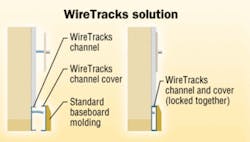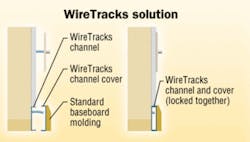WireTracks (www.wiretracks.com), a Seattle-based company, has entered the residential cabling component market, promising existing homeowners and businesses that their low-voltage cables can be hidden from sight.
The company is introducing a line of wiring channel products that are designed to let users "invisibly" add new low-voltage cabling to their existing homes or businesses. "I think our market is huge, because it is one where people are starting to see a lot of new technology show up, and they want it in their homes," says company president Bruce Gutman.
Gutman believes WireTracks' wiring channels represent an advance in the structured wiring marketplace. The solution consists of a wiring channel that is installed in-plane with drywall and a wiring channel cover. Gutman says these become an integrated unit once the installer attaches standard baseboard molding to the wiring channel cover. When users want to add new wiring, they simply remove the cover, install the new wiring, and replace the cover.
The market for residential cabling products appears to be growing. The U.S. Census reports that in August 2000, 54 million households (or 51%) had one or more computers, up from 42% in December 1998. Dataquest now reports that 28% of U.S. online households connect to the Internet via a broadband connection.
Gutman describes all of this interest as an opportunity for both homeowners and installers. "They see it as an opportunity to put wiring where they had difficulty before," says Gutman. "They didn't have the infrastructure in place in their homes, and they are now excited because they have the ability to know they can now run wiring."
Gutman says the challenge for installers and contractors will be introducing the WireTracks technology to much older homes or office buildings.
Newer office buildings are better designed to accommodate wiring changes because they have hollow ceilings, cubicles with built-in wiring channels, specialized racks within wiring closets, and other options. And in older homes and businesses, much of the wiring for the technologies of the day was run through the walls.
"But in a new home, this is easy to deploy. It only adds a small cost to the mortgage," says Gutman.

